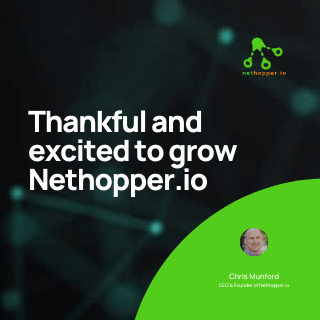Thankful and excited to grow Nethopper.io
- Chris Munford
- Jan 24, 2023
- 3 min read

We announced this week that Nethopper.io raised investment to further develop our Multi-Cloud Application products. I want to give thanks to our investor, Steve Papa, and give a little background on why Nethopper was born.
Steve is a very successful entrepreneur and investor, who doesn’t need much of an introduction in the tech world, but I’ll give him one anyway. In 1999, when the world was falling in love with the internet, Steve founded Endeca. But, that bubble burst in 2001, and Steve had to persevere over the next decade as he grew the company in troubled times. Then, just as Steve’s hard work was supposed to pay off, he had to weather the Great Recession in 2008-10.
In 2011, despite all hurdles, Steve managed a billion dollar plus exit to Oracle (NYSE: ORCL). Endeca was ahead of its time. (1) They pioneered the ‘big data’ movement before it became all the rage, and (2) They became a unicorn before the term ‘unicorn’ even existed. A short while later, when no VC would invest in Toast (‘restaurants, yuck, that’s a low margin business’), he saw the opportunity that others didn’t. Steve recognized, what was no less than, the digital transformation of the most popular activity in the world, ‘eating’. And this was before the term ‘digital transformation’ was popularized. Steve was proven correct when Toast (NYSE: TOST) IPO’d last year for over $30B.
Steve is now focused on 5G, mobility, and Edge Cloud, and this chapter is sure to be just as exciting as the last. To summarize, Steve is an innovator and investor in big ideas, and he sees things before others do. I’m so thankful to Steve for seeing what I see, and for giving me the opportunity to pursue my dream of founding a tech startup to solve an important problem.
I started my journey as a computer and network engineer. Over the next 20 years, I got out of the lab and in front of enterprise customers as a solution and sales guy. If you ask me what the top 4 major IT shifts have been, I’d put Public Cloud and Application MicroServices on the list, for sure (along with the Internet, and Data Analytics).
Like many people, I witnessed the birth of the public cloud in 2008. At first, it sounded like a rumor. It was all talk and no action, for a decade or more. But whispers grew into conversations, and around 2014, I noticed my customers starting to go to the cloud, one by one, project by project. Then, a switch flipped. CIOs became ‘cloud first’, and all future projects went to the cloud.
More recently, a similar thing has happened further up the stack, in application development. For decades, application teams have been running their apps on VMs. Then they started to dabble in containers a bit. Kubernetes was talked about as a coming technology, but too immature to actually use for production. Again, all talk and no action. But, in the last couple of years, one by one, my customers have started deploying their applications on Kubernetes. CIOs are now “Kubernetes first”, and all future applications will be run on Kubernetes.
In 2020, and as a solution architect for these customers, my job was to (1) give the infrastructure team what they wanted, lot’s of public cloud instances, and (2) give the application teams what they wanted, Kubernetes and microservices. Well, it turns out that I could not satisfy both teams, and this bothered me (and them).
Solutions repeatedly fell short in one or more areas like security, robustness, or complexity.
The fundamental problem was that Kubernetes (K8s) was made for a single cloud, and does not work across clusters and/or cloud instances. In networking terms, K8s is like having a LAN, but no WAN (ie. internet). With the number of applications, microservice, and clouds growing exponentially over the next decade, surely, the world would need a way to connect it all.
So, I set out on a mission to give Kubernetes the ability to span multiple clouds. We built a secure software solution. Today, we have a simple-to-use SaaS that works with all K8s, all networks, and all clouds (public and private). We have many features we’d like to add, and this investment from Steve will allow us to do that.
I am so thankful to Steve for giving Nethopper this opportunity, for all who have signed up for Nethopper SaaS, and for the talented team at Nethopper who believes in the vision of a multi-cloud Kubernetes future.
Chris Munford
CEO & Founder
See how Nethopper.io can help you, the value for our customers, or join our team HERE
